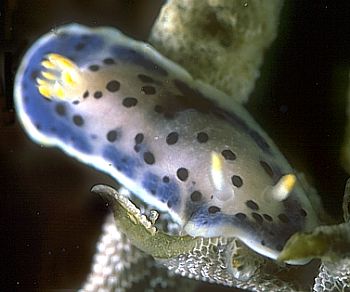
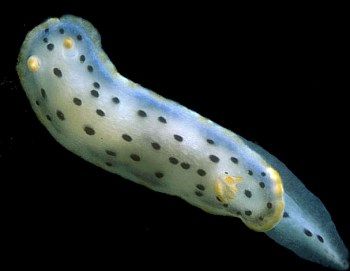
Hypselodoris placida
(Baba, 1949)
Order: NUDIBRANCHIA
Suborder: DORIDINA
Family: Chromodorididae
DISTRIBUTION
This species is known only from Japan and Hong Kong.
PHOTO
Hong Kong, April 1983. Photos: Bernard Picton.
This differs from Chromodoris orientalis in having smaller, more numerous black spots, a distinct white mantle border with a row of orange spots and a broad submarginal band of large elongate diffuse blue patches. On the foot there is an orange tip to the pointed posterior end but unlike C. orientalis there are no orange spots bordering the sides. It grows to at least 20 mm.
References:
• Rudman, W.B. (1983a) The Chromodorididae (Opisthobranchia: Mollusca) of the Indo-West Pacific: Chromodoris splendida, C. aspersa and Hypselodoris placida colour groups. Zoological Journal of the Linnean Society, 78: 105-173.
• Rudman, W.B. & Darvell, B.W. (1990) Opisthobranch molluscs of Hong Kong. Part 1. Goniodorididae, Onchidorididae, Triophidae, Gymnodorididae, Chromodorididae, (Nudibranchia). Asian Marine Biology, 7: 31-79
Rudman, W.B., 2001 (July 5) Hypselodoris placida (Baba, 1949). [In] Sea Slug Forum. Australian Museum, Sydney. Available from http://www.seaslugforum.net/find/hypsplac
Related messages
Hypselodoris placida and egg ribbon from Japan.
July 3, 2002
From: Jun Imamoto
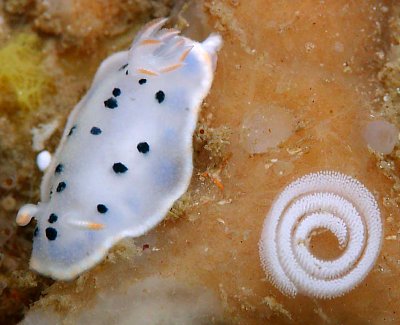
Dear Bill.
Here is a photo I took of Hypselodoris placida and its eggs. Many H. placida are laying eggs at present at this place. Hopefully it will be useful for your research.
Date: 22 June 2002
Location: Futou, Suruga bay, Japan
Size: about 14mm
Depth: 3m
Temperature: 20C
Best Regards,
Jun Imamoto
imamoto@wips.co.jp
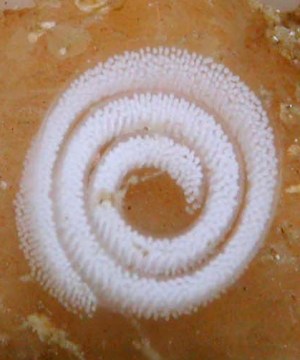
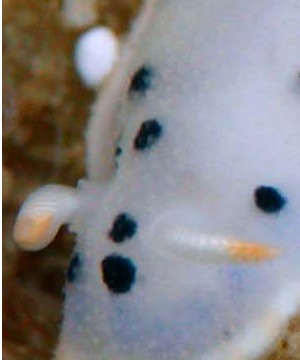
Dear Jun,
Thanks for this photo. It is a useful addition to our knowledge. I have also included a close-up of the the head as it shows the fine tubercles all over the mantle which, if you look at other photos on the Forum, seem to be a feature of this species. They remind me of the tubercles Jean-Pierre Bielecki recently illustrated for the Mediterranean species Hypselodoris orsinii.
Best wishes,
Bill Rudman
Hypselodoris placida from Japan
September 1, 2001
From: Nishina Masayoshi
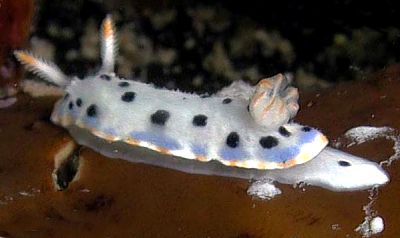
Dear Dr.Rudman,
Hypselodoris placida is one of the common species here like Chromodoris orientalis. I think the attached images animal are Hypselodoris placida. If so it has orange rhinophores and gills in Echizen. Therefore I sometimes misidentify it as Hypselodoris sagamiensis. At the same time, we also find specimens of H. placida with yellow rhinophores and gills like Brian Darvell's specimens. Baba described it in his book Opisthobranchs of Sagami Bay as having "rhinophores are yellow, tip of branchial plumes tinged with orange"
These photos were taken at Echizen Coast, Japan on 12 Aug, 2001. Length was between 20mm to 30mm
Best Regards,
Nishina Masayoshi
nishina@hpe15.wips.co.jp
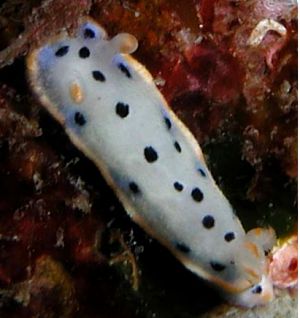
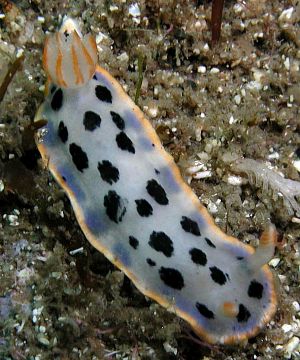
Dear Nishina,
Thanks for these photos of H. placida. Concerning the importance of colour differences. This is difficult. In some species slight differences in colour can indicate different species. However in most cases it is the total colour pattern of an animal which is important. In H. placida the colour pattern can be summarised as "translucent white mantle with black spots, a submarginal row of blue patches, orange or yellow broken line at mantle edge, orange or yellow edge to gills and upper half of rhinophore clubs". Although the yellow may sometimes be orange, and sometimes the spots around the mantle edge may be absent the rest of the pattern remains, and is different from other black-spotted species such as C. orientalis and H. sagamiensis.
There is no standard rule to say which differences are important in differentiating species - it differs with every species. This is why the range of photos you are sending is so valuable in furthering our understanding of these animals. It is also why I sometimes have to say "I am not sure" to some of the messages that are sent to the Forum.
Best wishes,
Bill Rudman
Hypselodoris placida from Hong Kong
July 11, 2001
From: Bill Rudman & Brian Darvell
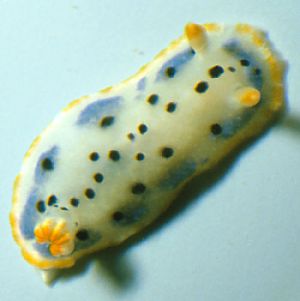
Here is some information and photos on Hypselodoris placida from Brian Darvell's Hong Kong collections.
PHOTO: AM C140240, 31 July 1983, Site 4.46, Kong Chau (N), Mirs Bay, 6 m. Photo: Brian Darvell
Hong Kong Collection Records. AM C133718, 21 February 1982, Site 4.8, Breaker Reef, Mirs Bay, 9 m. AM C133719, 2 specimens, 28 February 1982, Site 8.17, Bluff Is. (NE), 6 m. AM C133720, 23 March 1982, Site 7.25, Hoi Sing Wan, Tolo Harbour, intertidal. AM C140167, 24 July 1983, Site 11.87, South Ninepin (SE), 14 m. AM C140240, 31 July 1983, Site 4.46, Kong Chau (N), Mirs Bay, 6 m. AM C150353, 2 specimens, 4 April 1986 to 20 April, Tolo Harbour/Mirs Bay. Depth range: 0-14 m.
Reference:
• Rudman, W.B. & Darvell, B.W. (1990) Opisthobranch molluscs of Hong Kong. Part 1. Goniodorididae, Onchidorididae, Triophidae, Gymnodorididae, Chromodorididae, (Nudibranchia). Asian Marine Biology, 7: 31-79
Best wishes,
Bill Rudman & Brian Darvell
